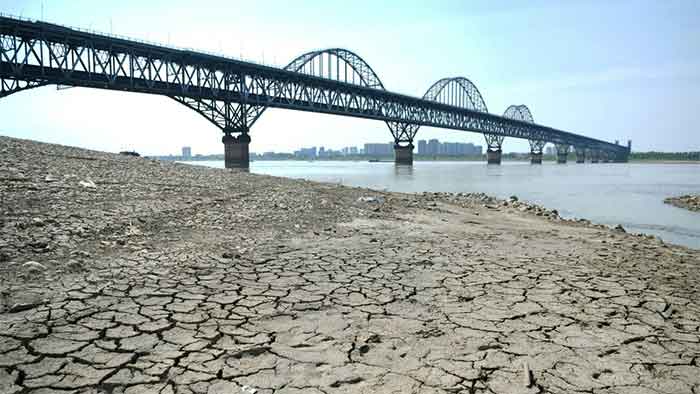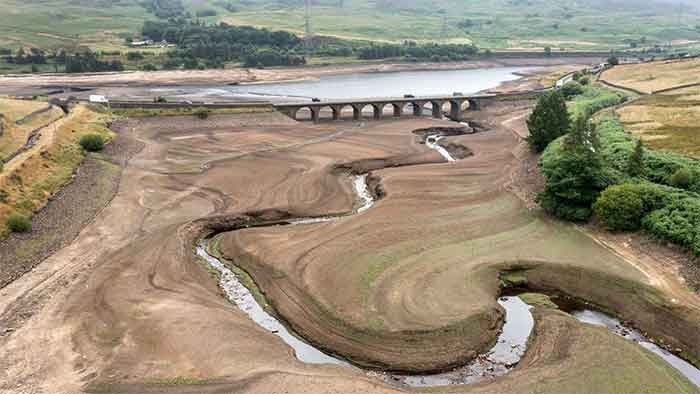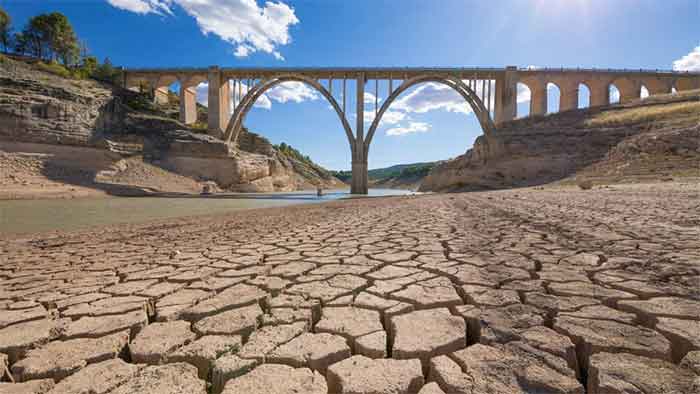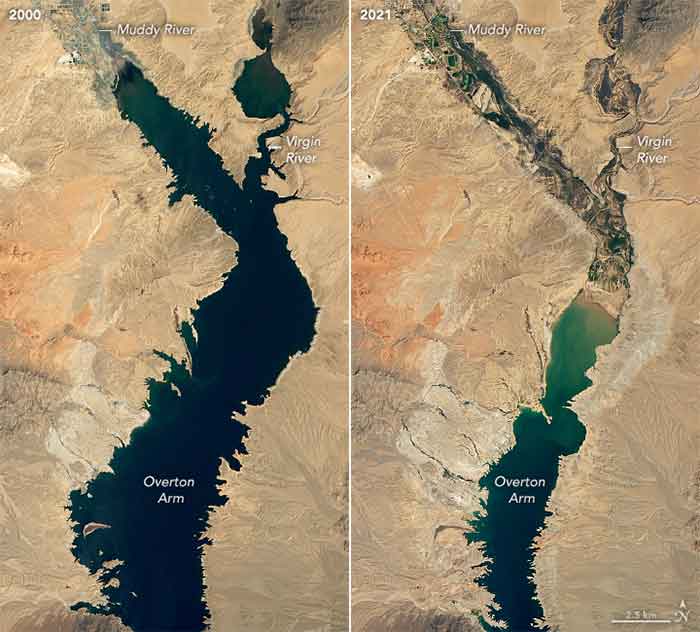
China has issued a nationwide drought warning for the first time in nine years as the country copes with below-average rainfall and one of the strongest heat waves seen in six decades. Authorities are trying to seed clouds to make it rain.
The drought is threatening food production, prompting the government to order local authorities to take all available measures to ensure crops survive the hottest summer on record.
The drought has dried up parts of the Yangtze River and dozens of tributaries, drastically affecting hydropower capacity and causing rolling blackouts and power rationing as demand for electricity spikes. There is now concern about future food supply.
China warned on Wednesday that the severe dry spell along the Yangtze could last well into September as local governments race to maintain power and find fresh water to irrigate crops ahead of the autumn harvest.
The order to divert water sources would probably help areas where water is inaccessible and subsidies have already been announced.
Media reports said:
The “yellow” alert, which was issued Friday, is the third-highest on China’s four-tier scale. It indicates that at least two provinces are facing drought-like conditions, and more dry weather or drought is expected.
On Tuesday, four government departments issued an urgent joint emergency notice, warning that the autumn harvest was under “severe threat”. It urged local authorities to ensure “every unit of water … be used carefully”, and called for methods included staggered irrigation, the diversion of new water sources, and cloud seeding.
A record-breaking heatwave combined with a months-long drought during the usual flood season has wreaked havoc across China’s usually water-rich south.
The drought has affected more than 2 million acres worth of farmland in six provinces.
Crop losses would also hit supply chains and exacerbate supply problems as a Chinese city’s produce supply was often grown close to that city, but would have to be sourced from further away and could rot on longer journeys.
The concerns were mainly domestic, and that categories of food that would affect the global markets were keeping pretty safe.
China is now relying more heavily on its own corn production – 4% of which was grown in drought affected Sichuan and Anhui – after Russia’s invasion of Ukraine drastically destabilized global supplies.
Tuesday’s notice heavily emphasized that it came from the highest levels of government, partially titled “emergency notice on thoroughly implementing the spirit of general secretary Xi Jinping’s important instructions”.
China’s meteorological agency said Friday that at least 244 cities across the country could see temperatures rise above 40 degrees Celsius, while another 407 could see the mercury rise to more than 37C. Forecasters expect the heat wave to could continue for another week, while the next three days will see little rain and continued drought development.
As of Wednesday, about 830,000 people across six provinces have had their water supplies affected by drought conditions, according to the Ministry of Water Resources.
More than 300,000 people are experiencing temporary difficulties even accessing drinking water. Provinces in southern and central China – especially those along the Yangtze River, such as Jiangsu, Hubei and Sichuan – are the most affected. Local officials have been advised to conserve water supplies for domestic purposes and reduce agricultural, commercial and industrial use.
The extreme heat has caused a spike in demand for air conditioning in offices and homes, putting pressure on the power grid. The drought has also depleted river water levels, reducing the amount of electricity produced at hydropower plants.
Sichuan, a province of 84 million people, has been gripped by extreme heat and drought since July. On Wednesday, Sichuan authorities ordered factories to shut for six days to ease heat-related power shortages.
Experts worry that the power rationing in a key manufacturing hub for semiconductors and solar panels could affect some of the world’s biggest electronics companies, including Intel and Foxconn.
Economists have also warned that the extreme temperatures could further drag down the world’s second-largest economy, which is already dealing with the effects of its strict Covid-19 lockdowns and a real estate crisis. Both Goldman Sachs and financial services firm Nomura lowered their forecasts for China’s GDP growth this year, citing in part the heat wave.
Yangtze Tributary Runs Dry
A Reuters report said:
Residents living near a tributary of the Yangtze river in the southwestern region of Chongqing clambered along the dry riverbed on Thursday amid an unprecedented drought across the region that could last another month.
“I am actually pretty worried, because the water has been cut off in my compound,” said Tian Feng, a 27-year old resident exploring the riverbed.
“Originally, I planned to see if I could walk directly from here to the other side of the river,” she said. “Because the water over there is still not dried out yet, I cannot cross.”
Though not completely dried up, dead fish were visible on the exposed flats of the Jialing, a long winding tributary that flows through three provinces before joining the Yangtze in Chongqing. Residents could safely reach a pier of the Qiansimen Bridge overlooking the river.
Normal water flows in the region could be months away, with rainfall expected to remain low until the end of this month and beyond, said Liu Zhiyu, an official at the Ministry of Water Resources, speaking at a briefing on Wednesday.
“It is expected that in September, water inflows in the middle and lower reaches of the Yangtze will still be low, and the drought in Anhui, Hubei, Hunan and Jiangxi could develop further,” Liu said, referring to four major provinces on the middle reaches of the river.
The severe heatwave across the Yangtze basin, caused by a larger-than-usual Western Pacific subtropical high, has lasted more than two months, reducing hydropower supplies and parching large expanses of arable land. The river supports about a third of the country’s population.
Beijing has warned of the increasing risk of extreme weather in China as a result of climate change, and heavy rainfall continues to take its toll in other parts of the country.
Flood
Flooding in the western Chinese province of Qinghai killed 16 people, state media reported on Thursday, with an additional 36 missing.
The Ministry of Finance said on Thursday that it would make 420 million yuan ($61.83 million) of emergency funds available to help local governments provide flood and drought relief.
Chongqing, where most of the Yangtze’s Three Gorges reservoir is located, is trying to secure power from other parts of the country as supplies to industry are rationed, state media reported.
China’s State Grid also promised to do its utmost to dispatch power to the neighboring Sichuan province, which normally supplies large amounts of surplus hydroelectricity to the east, but is now imposing strict consumption controls.
Companies with operations in Sichuan, including CATL, the world’s largest battery maker, and Japan’s Toyota, have suspended production in the province as a result of the restrictions, media reports say.
Rainfall in the Yangtze basin has been around 45% lower than normal since July, and high temperatures are likely to persist for at least another week, official forecasts said.
Authorities in the region also said temperatures would continue to exceed 40 degrees Celsius on Thursday, with parts of Chongqing set to go beyond 44 degrees.
Controlling water resources is seen as a crucial part of government in China as it tries to guarantee food supplies and secure another bumper harvest.
Rice and other autumn crops are at a “critical period” when it comes to irrigation, Liu Weiping, Vice-Minister of Water Resources, told the Wednesday briefing.
He said around 820,000 hectares (2 million acres) of arable land across the Yangtze basin have suffered damage, affecting 830,000 people as well as 160,000 head of livestock.
Water levels on the main trunk of the Yangtze and the flood basin lakes of Dongting and Poyang are now at least 4.85 meters (16 feet) shallower than normal, and the lowest on record for the period, officials said.
The Yangtze’s maritime safety bureau has issued several warnings about low water levels, ordering vessels to reduce their load when passing through shallower parts of the river.
The drought has also highlighted the role played by the cascade of giant hydropower projects in regulating flows on the Yangtze.
Giant upstream reservoirs are opening their gates to replenish storage levels at the Three Gorges Dam, which will release 830 million cubic meters downstream over the coming days.
Chongqing Deserted
In Chongqing, offices have been turning up the temperature of air conditioning and keeping the system off to rest from time to time for the purpose of reducing the burden of electrical loads and preventing the circuit breaker to trip, 34-year-old local resident Peng Rong told Reuters.
Hit by rare heatwave, 66 rivers across 34 counties in Chongqing have dried up, state television CCTV said on Friday (August 19) as weather service data showed a district in Chongqing to be the country’s hottest, hitting 45 degrees Celsius.

















































